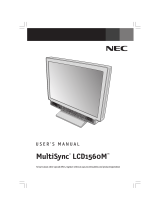NEC MultiSync® LCD1525M is a high-quality color monitor designed to meet the demands of professional users. With its 15-inch active matrix TFT LCD display, the MultiSync® LCD1525M delivers sharp images, vibrant colors, and excellent viewing angles. The monitor also features a variety of connectivity options, including analog and digital inputs, making it compatible with a wide range of computers and video sources. Additionally, the MultiSync® LCD1525M is TCO'99 certified, ensuring that it meets strict environmental standards.
NEC MultiSync® LCD1525M is a high-quality color monitor designed to meet the demands of professional users. With its 15-inch active matrix TFT LCD display, the MultiSync® LCD1525M delivers sharp images, vibrant colors, and excellent viewing angles. The monitor also features a variety of connectivity options, including analog and digital inputs, making it compatible with a wide range of computers and video sources. Additionally, the MultiSync® LCD1525M is TCO'99 certified, ensuring that it meets strict environmental standards.














-
 1
1
-
 2
2
-
 3
3
-
 4
4
-
 5
5
-
 6
6
-
 7
7
-
 8
8
-
 9
9
-
 10
10
-
 11
11
-
 12
12
-
 13
13
-
 14
14
-
 15
15
-
 16
16
-
 17
17
-
 18
18
-
 19
19
-
 20
20
-
 21
21
-
 22
22
-
 23
23
-
 24
24
-
 25
25
-
 26
26
-
 27
27
-
 28
28
-
 29
29
-
 30
30
-
 31
31
NEC MultiSync® LCD1525M Owner's manual
- Type
- Owner's manual
- This manual is also suitable for
NEC MultiSync® LCD1525M is a high-quality color monitor designed to meet the demands of professional users. With its 15-inch active matrix TFT LCD display, the MultiSync® LCD1525M delivers sharp images, vibrant colors, and excellent viewing angles. The monitor also features a variety of connectivity options, including analog and digital inputs, making it compatible with a wide range of computers and video sources. Additionally, the MultiSync® LCD1525M is TCO'99 certified, ensuring that it meets strict environmental standards.
Ask a question and I''ll find the answer in the document
Finding information in a document is now easier with AI
in other languages
Related papers
-
NEC MultiSync® LCD1525MBK Owner's manual
-
Mitsubishi Diamond Pro 740SB Owner's manual
-
NEC MultiSync® LCD1525MBK Owner's manual
-
NEC MultiSync® LCD1525MBK Owner's manual
-
NEC MultiSync® LCD1525MBK Owner's manual
-
NEC MultiSync® LCD1525MBK Owner's manual
-
NEC MultiSync® LCD1525MBK Owner's manual
-
NEC MultiSync® LCD1525MBK Owner's manual
-
NEC MultiSync® LCD1525MBK Owner's manual
-
NEC MultiSync® LCD1525MBK Owner's manual

































